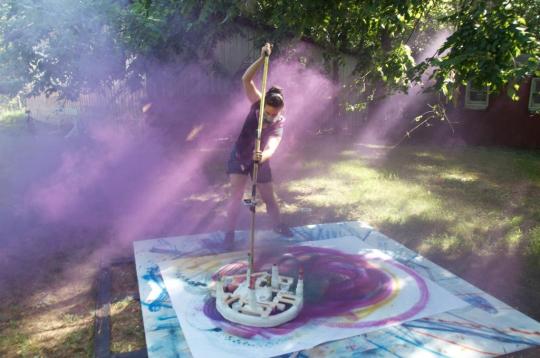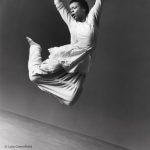How to Select an Artist Residency Program: Advice from Artist Rosemarie Fiore
“The type of residency I choose to apply to matches my goal for developing a specific body of work.”
Sometimes as an artist you need to break away from the routine of your life in order to reignite your creative process. Building a successful art career is filled with unique opportunities and completing a residency program is often a rite of passage. Artists often need to take significant time to re-focus their artistic practice and develop their craft.
There are tons of residencies’ programs that support artists in all disciplines. Residencies for painters. Experimental retreats. Whether you want to paint murals in Los Angeles or build bronze sculptures in Venice, you can find the perfect opportunity that fits your style.
Rosemarie Fiore (Fellow in Printmaking/Drawing/Artists’ Books ‘09) is a visual artist who experiments with raw materials to create beautiful highly detailed paintings. Her artistic achievements have lead her to various artist residencies, including Art Omi International Artists Residency Program, Yaddo, Skowhegan, The MacDowell Colony, Roswell Foundation AIR Program, Saltonstall Foundation AIR Program, Virginia Center for the Creative Arts, and the Bronx Museum.
Before you begin your residency research, we’ll provide you with a few resources, along with insight from Rosemarie on the benefits of participating in this one-of-a-kind experience.
NYFA: When looking for a residency program, how do you conduct your research?
RF: I conduct my research into fellowships and residency programs through word of mouth, social media and internet articles, along with databases such as NYFA Source and the Foundation Center.
NYFA: How do you evaluate artist residency programs?
RF: I understand what a particular residency program is all about. I look at a residency as a mini-marathon. I arrive with a goal and focus on reaching it. The type of residency I choose to apply to matches my goal for developing a specific body of work. There are four categories that most residency programs fall into:
First, some programs provide free studio space and usually open studios to the public and occasional studio visits from curators, collectors etc, such as the Sharpe-Walentas Studio Program in DUMBO or LMCC studio residency programs. Art OMI, Skowhegan and the Vermont Studio Center add guest lectures, accommodations and dining to the above. These residency programs are fantastic for exposure, creating connections and establishing your practice and presence in your field.
Other programs offer use of their studio or equipment, a stipend, and usually culminate in an exhibition of work produced. This could happen in collaboration with their skilled staff such as offered through Dieu Donne Papermill (Workspace Grant) or working independently at the Lower East Side Print Shop (Keyholder Residency Program). These types of residencies are great for exploring new media and ideas. Artists also have the opportunity to check out and learn from what fellow artists in the studio are working on.
A few residencies offer use of their studio equipment with tech help, accommodations, free studio and a stipend such as Sculpture Space in Utica, NY. This type of residency is perfect for hammering out ambitious work that requires a super shop with specific equipment and lots of tech help.
Lastly, there is the residency that provides space and time. Both the MacDowell Colony and Yaddo provide accommodations, dining, free studio and financial stipend available for qualified artists. Usually there is no open studio and you are completely supported and left alone to explore whatever you choose during your time there. Not only do you have an opportunity to plow through your own work, but you also have a chance to get to know the work of artists in other fields opening up the chance to collaborate and share.

According to Rosemarie, you should consider the following before applying to a artist residency program:
1. How long has the residency program been running and what is its reputation among artists?
Longer running programs usually have worked out their kinks, know what they are about, and are confident in what they provide artists. They anticipate your needs allowing you to focus on your work. I’ve found that artists are usually very honest with each other about their residency experiences and will share their thoughts with you if you ask them to.
2. What does the residency program require of the artist?
You might be required to pay money to go, open your studio to the public, or be at the residency a certain number of days per month. Some residencies may require that you leave them work for their auction. (I have heard of a residency that requires you join an artists trust.) I am always sure to read the contract the residency sends me before signing on the dotted line. This way I am certain I understand what is required on my end before I accept.
3. What are the studio facilities like, accommodations, transportation and dining?
I make sure the support the residency offers is a good match for what I need to focus on my work.
4. What advice would you give artist?
Every residency program is different. The goals, location, staff, dynamics, financial endowments etc, are all unique and specific to each residency. Understand that the primary goal of residency programs is to serve their artists. You will never have the same experience twice, but if you stay focused on your goals and really get into your work, you will come away from the experience with more than you had thought possible.
Residency Resources
Choosing the right residency requires lots of research. NYFA Source & NYFA Classifieds both offer excellent resources to discover artist residency opportunities.
NYFA Source
NYFA Source is an extensive database designed exclusively for artists. The directory is searchable and filled with prominent arts organizations and hundreds of artist residency programs. For example, you can find programs in major cities like Los Angeles or New York City. Maybe you’re interested in applying to rural residencies that offer more solitude. Or you’d like to build your artistic practice aboard in Naples or Berlin. All those opportunities exist in NYFA Source.
To kick off your search, visit: http://source.nyfa.org/ and use the search terms:
Award(s): Artist Communities/Artist-in-Residence Programs
Examples:
Bemis Artist-in-Residency Program
Here’s Artist Residency Program (HARP)
Brooklyn Arts Exchange Artists in Residence
NYFA Classifieds
NYFA Classifieds is the largest national online resource for jobs within the arts sector and artist opportunities, such as residencies, fellowships and open submissions. Use NYFA Classifieds to discover upcoming artist residency opportunities.
Visit our latest Artist Residency Roundup here.
Additional Online Resources
Remember, when selecting an artist residency program there are tons of possibilities! Conduct extensive research using the online resources at your disposal and ask questions of fellow artists. In the end, you’ll have the ability to pick the perfect residency program that works best for you.
– Glory Edim, Program Associate, Online Resources
Images & artwork from Rosemarie Fiore





